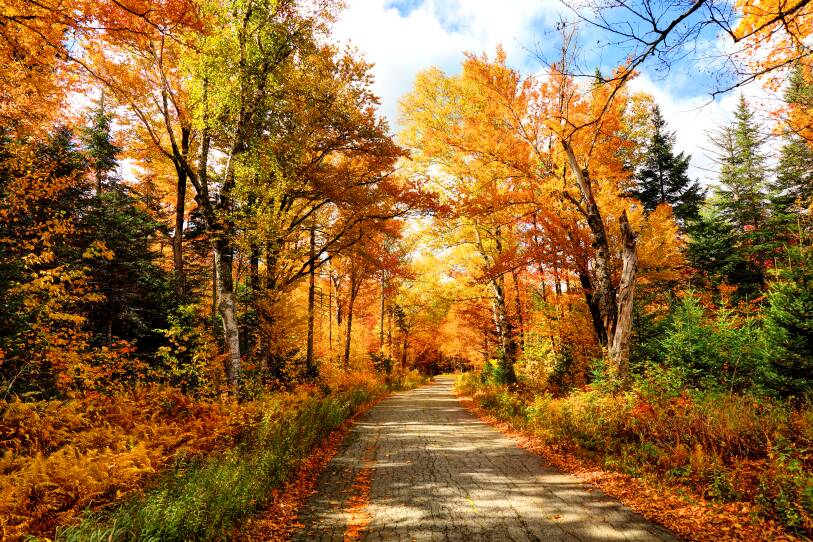Climate change is real. The science doesn’t lie, and as each year arrives with a new climate disaster, we’re granted more data to illustrate how dire the situation really is. But data aside, some of these consequences are obvious. Summer is getting hotter. Winter is getting weirder. Spring blooms come later. And autumn, that season of cozy flannels and boots and crisp air and foliage... what is going on there?
“For whatever reason, [fall] has been an overlooked season to some degree,” said Jason Smerdon of the Lamont-Doherty Earth Observatory at Columbia University. “Most of what you hear on all these phenology studies focus on the spring or the summer and winter seasons. But fall is, for whatever reason, sometimes overlooked.”
It shouldn’t be. A changing climate’s impact on autumn is as fascinating as it is terrifying.
Every year, on September 22, a joke is tossed around by my friends: “Is this it? Is this the final autumn?” It certainly feels like it. As someone with a birthday on the precipice of the crispest season, my memory is of wearing a sweater (or at least long sleeves) on that special day and of leaves that turned sooner and stayed prettier for longer. “But memory is fickle and time is relative,” I thought. “So maybe I’m just wrong.”
I’m not. Not quite, at least.
For starters, there’s the question of foliage, the brilliant shock of yellows and oranges and reds that engulf the forests of New England this time of year. It turns out that the leaves are indeed changing later than they used to — about two weeks later than they did back in the 1980s or 1990s, according to Smerdon.
Cooler temperatures don’t exactly cause leaves to change, but they are a trigger that gets the process started. In response to that trigger, “the trees will stop producing[ing] chlorophyll and will start to draw nutrients back into the plant from the leaves,” said Ben Cook, also of Lamont-Doherty. The leaves age and drop and the tree remains dormant into the winter. When the days start to get warmer, the tree knows it’s time to ramp up its leaf game. So, if you’re getting a string of 75-degree days in mid-October, like we have this year, those trees will hang onto their leaves for longer.

But foliage is only one part of this autumnal equation; a warming climate has ramifications that reach far beyond beautiful leaves. The climate crisis is affecting tree migration, too.
The sugar maple is one of the most brilliant and recognizable trees in the region. As Smerdon puts it, this species “contributes so much to our fall colors and has such an important place in our thinking about Northeastern falls.” But what researchers are discovering is that these trees are inching ever northward, into Canada, to escape the increasingly warming climes of the Northeastern United States. As Cook explains, when a tree’s seeds are dispersed, the ones that are found in the northern reaches of that tree’s range are thriving and surviving, thanks to the cooler climate.
“Basically,” he said, “the conditions at that kind of range limit become a lot more conducive to these species and a lot more favorable.”
This tree migration works both ways, though. As New England fall classics like elm, ash, spruce, and firs grow strong into Canada, tree species from our southern neighbors are also on the move.
“Shortleaf pines, oak and hickory forests will move north into the northeast,” said Smerdon. “It's not just a matter of the timing changing, but the species' distribution over longer timescales will actually change as temperatures warm in the Northeast.”
And here’s the kicker: “Some worst case scenario projections estimate that by the end of the century, the Northeast would have a climate more akin to something like South Carolina,” said Smerdon.
Warmer autumns don’t just affect trees. They affect us too. You ever notice how, when the air gets a bit chillier, certain pests kind of go away? No mosquitoes sucking your blood; ticks becoming less of a nuisance? Well, their activity is closely tied to the temperature, so a longer warm period means a longer active period for them, which means increased incidences of diseases like West Nile Virus for us.
"Some worst case scenario projections estimate that by the end of the century, the Northeast would have a climate more akin to something like South Carolina."Jason Smerdon, Lamont-Doherty Earth Observatory
Fall “means the end of allergy season,” said Cook. “These cold temperatures kill pests and kind of reset the whole system. So if autumns are getting warmer and kind of delaying the start of the rest period, then that has some really big ramifications for people and ecosystems.” Ecosystems, and economies, too.
Autumn tourism is intense. Leaf peepers ride vintage trains like the Scenic Railroad of North Conway, New Hampshire, to marvel at autumn’s arboreal majesty. Flannel and legging-clad couples pay lots of money to pick apples at quaint orchards. Pumpkin patches make for grade-school field trips; hay rides are… a thing, for someone. All of that is tied to autumn as not only a season, but as a cultural idea.
If there’s anything I learned from thinking and reporting on this topic, it’s that Fall will always be a thing — but, eventually a shorter, warmer thing. As Smerdon reminded me, autumn will be here. But it’s going to look different.






